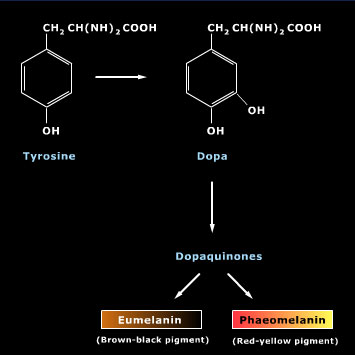The color of hair can be explained by a little bit of biology, chemistry, and physics. Let’s start with the physics. Hair color is determined by the absorption and reflection of light and it is based on the amount and the type of melanin1 present (this is genetically determined). For example, when light hits white or blond hair, which contain little melanin, almost all of the light is reflected, and this reflected light contains all parts of the visible spectrum. When light hits brown hair, which contains moderate amounts of melanin, some of the light is absorbed, and the reflected light appears colored. The actual color depends on the type of melanin present in the hair. Black hair absorbs almost all light that hits it because it has a lot of melanin. Little light is reflected and the hair appears black.
Second, some biology: Melanin is contained in granules in cells called melanocytes2, but it can not provide any color when sequestered in this way; it must be transferred to another type of cell called keratinocytes3. The melanocytes are scattered about, mostly in the bulb and in the cortical layer of the hair, sandwiched between the numerous keratinocytes. The melanocytes have long tendrils or dendrites that make contact with the keratinocytes. The keratinocytes actually phagocytize the tips of the melanocyte dendrites, stealing a portion of melanocyte cytoplasm that contains the melanin granules. Once inside the keratinocytes, the melanin is able to absorb light, which gives the hair color.
Melanins are the most widely occurring pigments in nature. In addition to giving hair its color, melanins give color to eyes, freckles, skin, scales, and feathers. They are also responsible for the browning of plants. However, melanin is important for more than just hair color. This biopolymer is able to bind drugs4 just as receptors5 bind to drugs. In order to understand how this happens, it is helpful to understand how melanin is made and its basic structure. And finally, some chemistry: within the melanocytes, melanin is synthesized from tyrosine6, a naturally occurring amino acid that is also found in neurons where it participates in the synthesis of the neurotransmitter, dopamine7 (see Module 3). Different enzymes8 are found in melanocytes and in dopamine neurons to synthesize melanin or dopamine from the same starting material (tyrosine). For example, with the help of the enzyme tyrosinase9 and some copper, tyrosine is oxidized by O2 eventually into special dopaquinones that have color (Figure 5).
Figure 5 Melanin is synthesized (oxidized) from tyrosine with the help of the enzyme tyrosinase.
The dopaquinones are then bound together in a long strand (polymerized) to form melanin (Figure 6). These polymers contain numerous carboxyl groups (COOH) giving melanin an acidic character. However, at normal cellular pH of 7.4, the COOH tends to donate a H+ leaving an overall negative charge (COO-) on melanin.
Figure 6 Melanin is a polymer of dopaquinones. The X indicates additional groups containing COOH. The COOH groups tend to lose the H atom leaving them with a negative charge.
Definitions:
1 the pigment found in hair, skin, feathers, etc.. It is a biopolymer found in granules within melanocytes and transferred to keratinocytes to provide hair color.
2 the cells in the hair matrix and in the cortex that synthesize melanin.
3 the cells in which keratin is synthesized within the follicle
4 a substance that affects the structure or function of a cell or organism.
5 a protein to which hormones, neurotransmitters and drugs bind. They are usually located on cell membranes and elicit a function once bound.
6 an amino acid found in melanocytes and in neurons that is the starting material for the synthesis of melanin and dopamine, respectively.
7 a neurotransmitter stored in vesicles of nerve terminals; it is a monoamine that is easily oxidized. This neurotransmitter is contained in neuron pathways important in brain stimulation, addiction and control of movement.
8 a protein that catalyzes the rate at which a reaction occurs. It binds to one of the reactants (a substrate) to cause a change in the reactant’s structure, facilitating the reaction.
9 the enzyme found in melanocytes that is required to help oxidize tyrosine to make melanin. Without tyrosinase, there is no hair pigmentation.


